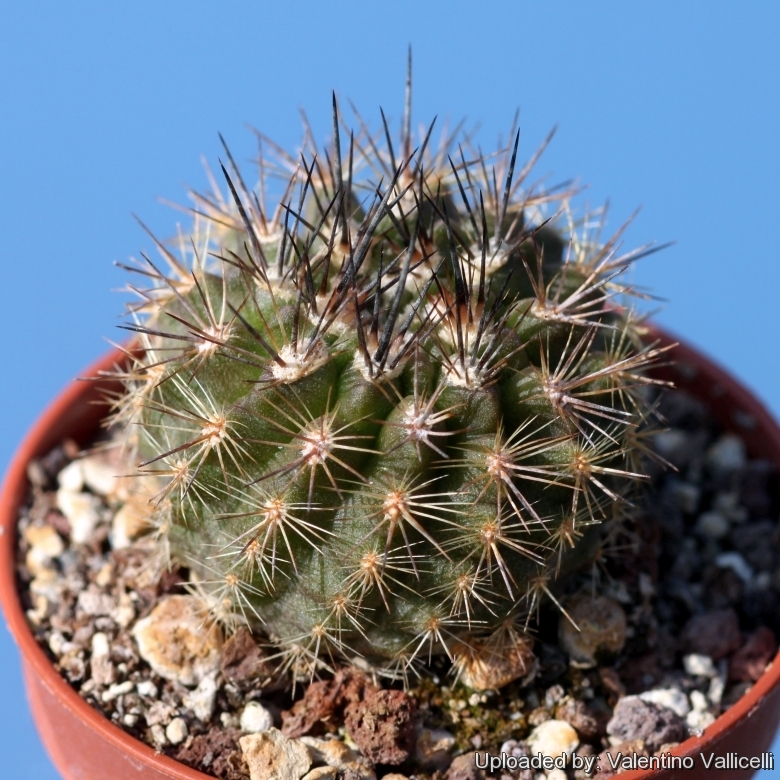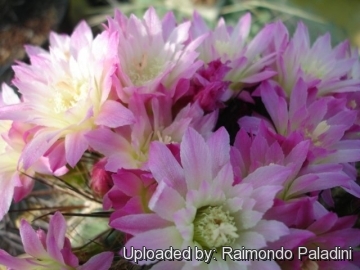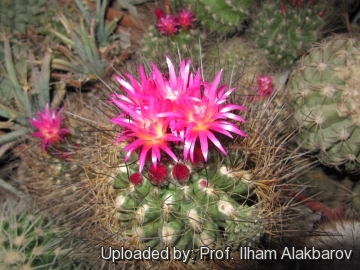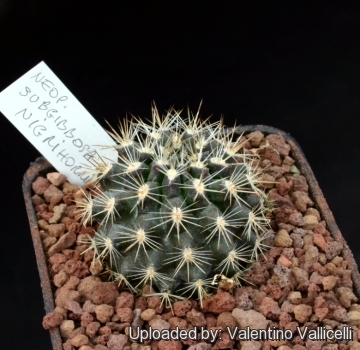= Eriosyce subgibbosa var. nigrihorrida (Backeb. ex A.W.Hill) Katt.
Eriosyce (Cactac.) gen. revis. & ampl. (Succ. Pl. Res., 1) 119. 1994 with incorrect basionym and basionym reference, Neoporteria nigrihorrida Backeb." cited as basionym, itself a comb. nov. based on Chilenia nigrihorrida Backeb. ex A.W.Hill
Accepted Scientific Name: Eriosyce subgibbosa subs. clavata (Söhrens ex K.Schum.) Katt.
Eriosyce (Cactac.) gen. revis. & ampl. (Succ. Pl. Res., 1) 119 (1994)

Neoporteria clavata var. nigrihorrida (Eriosyce subgibbosa var. nigrihorrida) Photo by: Valentino Vallicelli
FK 182 (Collector: Friedrich Kattermann) 20km North of La Serena, Elqui, Chile. Altitude: 10m (= Neoporteria aff. litoralis)
Origin and Habitat: South Coquimbo, Chile.
Synonyms:
See all synonyms of Eriosyce subgibbosa
back
Accepted name in llifle Database:Eriosyce subgibbosa (Haw.) Katt.Eriosyce (Cactac.) gen. revis. & ampl. (Succ. Pl. Res., 1) 119 (1994)Synonymy: 69
Accepted name in llifle Database:Eriosyce subgibbosa subs. clavata (Söhrens ex K.Schum.) Katt.Eriosyce (Cactac.) gen. revis. & ampl. (Succ. Pl. Res., 1) 119 (1994)Synonymy: 40
back
Description: The Eriosyce subgibbosa var. nigrihorridaSN|2931]]SN|2558]] much better known under its old name, Neoporteria nigrihorridaSN|2561]]SN|2561]] is one of the innumerable and controversial form and variety of Eriosyce subgibbosaSN|2558]]SN|2931]] which is a very variable species. The “nigrihorrida” has mostly globose dark grey-green to blackish-green body and very stout straight spines which are pitch-black in the crown The flowers are bi-coloured with carmine petal tips and yellowish-white throat.
Stem: Solitary mostly globular, up to 90 cm tall (or more), up to 10 cm wide. Grey-green, yellowish-green, brownish-green or blackish-green.
Ribs: (11-)16-20(-22) more or less notched with chinlike protrusions.
Areoles: Large and woolly.
Spines: Partially hiding the ribs, needle like, more or less long and dense, white, yellowish, golden yellow, brown, or nearly black, while older one became greyish.
Radial spines: (8-)16-24(-40), 1-2(-3) cm long, radiating.
Central spines: 4 to 8, occasionally up to 16, stronger, up to 4 cm long,straight or recurved and spreading, often darker at the tips..
Flower: Pretty relatively small, tubular, up to about 3-5 cm long, bi-coloured with carmine petal tips and pinkish-white, white or yellowish-white throat, giving the sensation of being fluorescent and being very difficult to photograph in good conditions because that particularity. Inner tepals erect, acute, concealing the stamens.
Blooming season: Blooms early in late winter to spring. It is advisable to leave them dry from middle of November to obtain fantastic flowering later in January/March.
Fruits: Ovoid to cylindrical, 1,5-2 cm long, 1 cm in diameter, red or reddish-green partly hollow at maturity, only scarcely woolly, apical areoles not spinescent.
Remarks: This species as many (very controversial) varieties.
More...Subspecies, varieties, forms and cultivars of plants belonging to the Eriosyce subgibbosa group
Bibliography: Major references and further lectures
1) Edward Anderson “The Cactus family” Timber Press, Incorporated, 2001
2) Nathaniel Lord Britton, Joseph Nelson Rose “Cactaceae: Descriptions and Illustrations of Plants of the Cactus Family” vol. 4 The Carnegie Institution of Washington, Washington 1923
3) James Cullen, Sabina G. Knees, H. Suzanne Cubey "The European Garden Flora Flowering Plants: A Manual for the Identification of Plants Cultivated in Europe, Both Out-of-Doors and Under Glass" Cambridge University Press, 11/Aug/2011
4) David R Hunt; Nigel P Taylor; Graham Charles; International Cactaceae Systematics Group. "The New Cactus Lexicon" dh books, 2006
5) "Succulent Plant Research" Volume 1, David Hunt, Richmond 1994, page. 117.
6) Fred Kattermann “Eriosyce (Cactaceae): The Genus Revised and Amplified” David Hunt, 1994
7) E Haustein “Der Kosmos Kakteenfuehrer (the Kosmos Cactus Guide)” Balogh Scientific Books 01 December 1998
8) Hans Hecht “BLV-Handbuch der Kakteen” BLV-Verlagsgesellschaft, 1982
9) Terry Hewitt “Cacti” Lorenz Books, 01/Apr/1998
More... Neoporteria clavata var. nigrihorrida (Eriosyce subgibbosa var. nigrihorrida) Photo by: Raimondo Paladini
Neoporteria clavata var. nigrihorrida (Eriosyce subgibbosa var. nigrihorrida) Photo by: Raimondo Paladini - Listed under incorrect name of Neoporteria nigrispina (not even a viable synonym) (Eriosyce subgibbosa var. nigrihorrida) Photo by: Prof. Ilham Alakbarov
- Listed under incorrect name of Neoporteria nigrispina (not even a viable synonym) (Eriosyce subgibbosa var. nigrihorrida) Photo by: Prof. Ilham Alakbarov A juvenile specimen. (Eriosyce subgibbosa var. nigrihorrida) Photo by: Valentino Vallicelli
A juvenile specimen. (Eriosyce subgibbosa var. nigrihorrida) Photo by: Valentino VallicelliSend a photo of this plant.The gallery now contains thousands of pictures, however it is possible to do even more. We are, of course, seeking photos of species not yet shown in the gallery but not only that, we are also looking for better pictures than those already present.
Read More... Cultivation and Propagation: It is a summer-growing species of relatively easy cultivation that continues to be, a particular prize among collectors. This plant is extremely xerophytic, adapted to very dry soils and is quite susceptible to over-watering if kept in a non ventilated place.
Growth rate: Slow-growing.
Soil: Grow it in an open mineral, sandy-gritty cactus compost and provide a very good drainage.
Exposure: It is suited for sunny-brightly exposure, but can tolerate light shade. However it will do its best only with lots of sun and become stressed with inadequate light which could result in poor growth and unnatural shape. It has a good heat tolerance.
Watering: Water sparingly and keep it completely dry during winter. Mature individuals easily rot and die especially after transplanting so be extremely cautious with watering. Keep dry in winter or when night temperatures remain below 10° C. Water it less than average if in bigger pots.
Fertilization: Feed them once during the growing season with a fertilizer specifically formulated for cactus and succulents (high potash fertilizer with a dilute low nitrogen), including all micro nutrients and trace elements diluted to ½ the strength recommended on the label. They thrive in poor soils and need a limited supplies of fertilizer to avoid the plants developing excess vegetation, which is easily attacked by fungal diseases.
Special need: It is suited for airy exposures. Provide very good ventilation. Nearly all problems occur as a result of overwatering and poor ventilation, especially when weather conditions are dull and cool or very humid. They must have very dry atmosphere.
Hardiness: It likes warmth (recommended minimum winter temperature 5° C) But plants kept perfectly dry can easily survive to winter night temperatures below 0° C.
Pests & diseases: These cacti may be attractive to a variety of insects, but plants in good condition should be nearly pest-free, particularly if they are grown in a mineral potting-mix, with good exposure and ventilation. Nonetheless, there are several pests to watch for:
- Red spiders: Red spiders may be effectively rubbed up by misting the plants from above.
- Mealy bugs: Mealy bugs occasionally develop aerial into the new leaves and flowers with disfiguring results, but the worst types develop underground on the roots and are invisible except by their effects.
- Scales, thrips and aphids: These insects are rarely a problem.
- Rot: Rot is only a minor problem if the plants are watered and “aired” correctly. If they are not, fungicides won't help all that much.
Propagation: Usually propagated from seeds (seldom produces offsets) or graft. The seeds can be sown in pots of fine, well-drained sandy soil, any time during the spring when temperatures are warm. Cover the seeds with a fine layer of grit and water from below with a fungicide to prevent damping off. For the 1-2 weeks cover the pots with a sheet of glass/clear perspex to keep the humidity levels high. Remove the glass and replace it with light shade-cloth and mist once or twice a day for the next two weeks after which most seeds should have germinated. From then on mistings can be reduced to every second and then every third day as the little plants grow. The seedlings should not be disturbed until they are well rooted after which they can be planted separately in small pots. Sometimes it is grafted to avoid root rot problems as plants grafted on an hardy stock are easy to grow and no special skill is required.
More...













